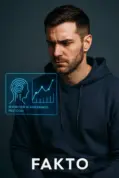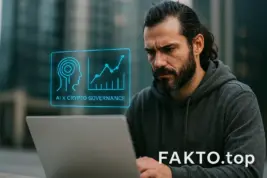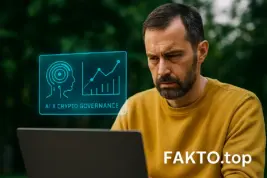AI x Crypto Governance: Autonomous Protocols for the Next Cycle
AI x Crypto Governance: Autonomous Protocols Are Already Here
Let’s be honest — manual governance in crypto is starting to feel like dial-up internet. Endless voting rounds, low participation, whales swinging outcomes, and DAOs stuck in decision limbo. Meanwhile, protocols are scaling, liquidity is flowing, and builders are asking: can we automate some of this mess?
Enter AI-powered governance. Not just bots. Not just dashboards. We’re talking agentic crypto systems — autonomous agents that monitor treasury health, propose upgrades, optimize parameters, and even vote based on predefined logic. Sounds wild? It’s already happening.

Wait, Are We Talking About AI Running DAOs?
Kind of. Not full Skynet — but smart agents that help DAOs move faster, cleaner, and with less burnout. Think of it like autopilot for governance. You still set the rules, but the system handles the execution. Projects like Gnosis Safe + AI modules, Agent TINFOIL, and AI-enhanced treasury bots are already testing this.
Why Does This Matter?
Because governance fatigue is real. Builders are tired. Token holders are disengaged. And protocols need to evolve — not wait for 3% quorum on a Tuesday. AI agents can:
- Monitor KPIs and trigger proposals
- Simulate outcomes before voting
- Auto-adjust staking rewards based on usage
- Flag anomalies in treasury flows
- Handle low-risk upgrades autonomously
It’s not about replacing humans — it’s about augmenting governance. Giving DAOs the tools to scale without losing their soul.
But Can We Trust AI in Governance?
Good question. Trustless systems are the goal. That’s why most AI agents in crypto are built with transparent logic, on-chain execution environments, and zk-proof validation. You can audit them. You can override them. You can fork them. It’s not black-box AI — it’s crypto-native orchestration.
Examples Already Live (Yes, Really)

- Fetch.ai: Autonomous economic agents for DeFi coordination
- Hyperliquid: AI-enhanced trading and governance analytics
- Aragon + AI modules: Proposal scoring and auto-routing
- Superfluid: Real-time treasury flows with AI triggers
- DAOhaus: Exploring agentic voting logic
These aren’t just whitepapers. They’re shipping. And the next cycle will be full of protocols that don’t wait for humans to click “yes.”
So What’s the Catch?
AI governance isn’t plug-and-play. You need:
- Clear protocol goals
- Transparent agent logic
- Fallback mechanisms
- Community buy-in
Otherwise, you risk turning your DAO into a vending machine with no refund button. The best setups combine human intent with machine execution.
Is This Just a Trend?
Nope. It’s a shift. From manual governance to autonomous protocol design. From voting fatigue to AI-enhanced coordination. From static rules to adaptive crypto systems. And if you’re building, investing, or contributing — this is your signal to explore it.
In the next part, we’ll break down real-world use cases, common pitfalls, and how to exit governance chaos without rage-quitting your DAO.
How AI Agents Work in Crypto Governance
Step-by-Step Breakdown
- 1. Monitor: AI agents track protocol metrics — treasury balance, staking activity, gas fees, user growth.
- 2. Analyze: They run simulations, detect anomalies, and compare performance to historical data.
- 3. Propose: Based on logic rules, agents draft governance proposals — like adjusting rewards or upgrading contracts.
- 4. Execute: If approved (or auto-authorized), agents trigger smart contracts to implement changes.
- 5. Audit: All actions are logged on-chain. Anyone can verify, override, or fork the logic.
Real-World Use Cases
- Treasury Management: AI adjusts budget allocations based on usage and runway.
- ⚙️ Protocol Tuning: Agents optimize staking rates, fees, and liquidity incentives.
- ️ Governance Routing: AI filters proposals, scores them, and routes to relevant voters.
- ️ Security Alerts: Agents flag suspicious wallet behavior or contract exploits.
Why It Matters
AI agents don’t replace humans — they reduce friction. They help DAOs move faster, avoid burnout, and stay adaptive in volatile markets. Think of them as protocol copilots — always watching, always optimizing, never sleeping.
Feeling Stuck in DAO Governance? You’re Not Alone
If you’ve ever rage-quit a DAO vote, ignored a proposal, or stared at a governance dashboard wondering “what now?” — welcome to the club. Even the most seasoned crypto builders hit walls. Governance fatigue, low turnout, unclear metrics, endless debates — it’s a real thing. But here’s the good news: AI agents aren’t just theory. They’re tools to help you move forward.

Whether you’re managing a treasury, designing tokenomics, or just trying to keep your community engaged — autonomous governance can reduce friction, boost clarity, and give your protocol room to breathe. Below is a quick comparison of common pain points and how AI agents can help.
Manual vs Autonomous Governance: What Changes
| Problem | Manual Governance | AI-Enhanced Governance |
|---|---|---|
| Low voter turnout | Proposals stall, quorum not met | Agents auto-route proposals to relevant voters |
| Burnout from constant voting | Core contributors disengage | Agents handle low-risk decisions autonomously |
| Slow treasury adjustments | Manual budget votes every month | AI monitors KPIs and adjusts flows in real time |
| Security blind spots | Delayed human response to anomalies | Agents flag and act on suspicious behavior instantly |
| Proposal overload | Too many ideas, not enough filtering | AI scores and prioritizes proposals based on impact |
| Static tokenomics | Fixed parameters, slow upgrades | Agents simulate and propose dynamic adjustments |
Final Thoughts: You Don’t Have to Solve It Alone
Crypto governance doesn’t have to be a grind. With the rise of AI-powered agents, we’re entering a new phase — one where protocols can evolve without burning out their communities. You still set the vision. You still hold the keys. But now, you’ve got help.
If you’re building a DAO, contributing to one, or just exploring — start small. Test an agent. Automate a metric. Simulate a vote. The future of governance isn’t about replacing humans. It’s about empowering them to build better, faster, and with less friction.
And if you’re standing at a crossroads, wondering what’s next — maybe it’s time to let the machines take the wheel (just a little).
